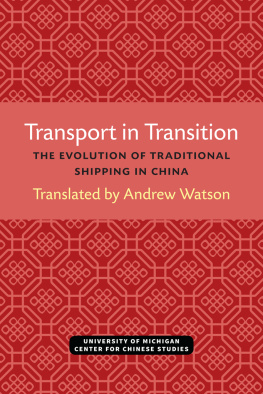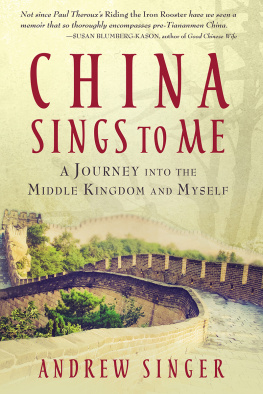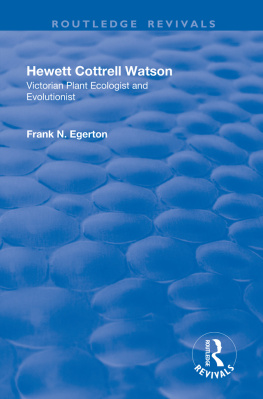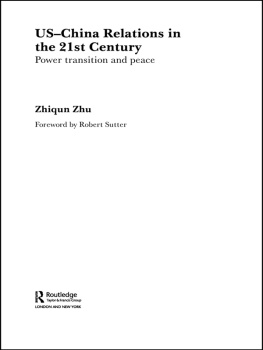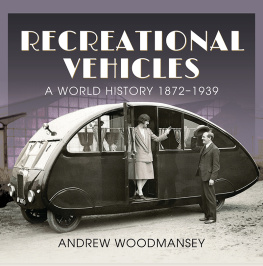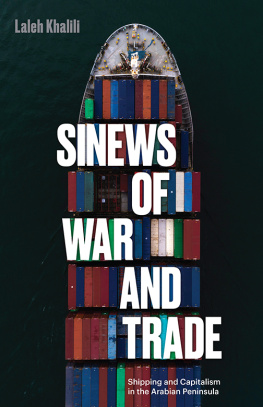THE UNIVERSITY OF MICHIGAN CENTER FOR CHINESE STUDIES
MICHIGAN ABSTRACTS OF CHINESE AND JAPANESE WORKS ON CHINESE HISTORY
Mark Elvin, Editor
Ann Arbor, Michigan
TO MY PARENTS
TRANSPORT IN TRANSITION
The evolution of traditional shipping in China
Translations by Andrew Watson
Michigan Abstracts of Chinese and Japanese Works on Chinese History
No. 3
1972
Originally published in Japanese as
Koizumi Teiz, Shina minsen no keiei ni tsuite, (Keizai rons , 57, 3, (Sept. 1943), pp. 6692).

Nakamura Yoshio, Sen han , (Tsingtao: Kahoku Kgy Skkai, 1941).

Mantetsu Chsabu, Chshi no minsengy , (Tokyo: Hakubunkan, 1943):

;

;

.

Ksaka Toriz, Chgoku keki kik no kenky , (Waseda daigaku shuppanbu, 1949).

Nakamura Yoshio, Minsen no eigy hh ni tsuite, (Kahoku kgy , 11, Tsingtao (Sept. 1941), pp. 34-38).

ISBN 0-89264-903-8
Translation 1972
by
Center for Chinese Studies
The University of Michigan
Printed in the United States of America
ISBN 978-0-89264-903-7 (paper)
ISBN 978-0-472-12761-0 (ebook)
ISBN 978-0-472-90156-2 (open access)
Contents
A translation of the Boat Agreement which appears on the back cover will be found at the end of the book.
It has long been apparent to teachers of Chinese history at universities that a major obstacle in the way of creating a balanced syllabus is the uneven coverage of the subject-matter provided by secondary works in the English language. At the same time there has existed for many decades a rich and important secondary literature in Chinese and Japanese, and one that is constantly growing. The language barrier is such as to make this literature almost inaccessible to undergraduates and still difficult for students at the post-graduate level, while the cost of making full and accurate translations, in terms of the few scholars qualified to do so, is prohibitive. The present series is designed to find a way around this impasse, in the belief that if the major results of this Chinese and Japanese secondary literature can be made widely available to those studying Chinese history at universities, this will raise the level of knowledge and understanding with a speed possible in no other way.
The approach we have adopted is that of the long summary, more substantial than the customary abstract, but still confining itself only to essentials and stripped of critical apparatus and notes. It approximates to the working notes that one makes when reading an important Chinese or Japanese secondary work for the first time, and the immediate historical precursor of the series is of course the exchange of such notes which has long been customary among colleagues working in this particularly exacting field. A primary advantage of a condensation of this kind is that it is much less demanding of a contributors time than a full-dress translation would be, while omitting little if anything of significance to the general student or reader.
The course which I teach on the economic and social history of China at the University of Glasgow has shown the great value of abstracted translations such as the present one for undergraduates. Hopefully, they may also prove of help to research students who need to read around the edges of their main area of concentration, to maturer scholars working in areas of Chinese studies relatively remote from the subject of a given abstract but anxious to fill in the background for the purposes of teaching or general interest, and to those pursuing comparative cross-cultural studies in the social sciences at large.
The present volume, by Andrew Watson of the Department of International Economic Studies at Glasgow, breaks new ground for the series in presenting summarized translations of a number of scholarly articles grouped around a central theme. We hope to extend the use of this approach in the future on other important topics where there is no single volume sufficiently good to merit translation on its own.
The series as a whole owes its existence to the generosity and vision of Professor Rhoads Murphey and Professor Albert Feuerwerker of the Center for Chinese Studies at the University of Michigan. I should like to acknowledge with gratitude their continuing enthusiasm and support.
Mark Elvin
Series Editor
The great extent of the empire of China, the vast multitude of its inhabitants, the variety of climate, and consequently of productions in its different provinces, and the ease of communication by means of water carriage between the greater part of them render the home market of that country so great in extent, as to be alone sufficient to support very considerable subdivisions of labor.
Book IV, Chapter IX.
Through the greater part of Europe too the expense of land-carriage increases very much both the real and the nominal price of most manufactures.... In China and Indostan the extent and variety of inland navigations save the greater part of this labor, and consequently of this money, and thereby reduce still lower both the real and the nominal price of the greater part of their manufactures.
Book I, Chapter XI.
Adam Smith, An Inquiry into the Nature and Causes of the Wealth of Nations (1776)
Adam Smith can have had little detailed knowledge of the extent and nature of water transport in China. Yet, by emphasizing its magnitude and comparative efficiency, he showed a remarkably acute understanding of a major feature of the traditional Chinese economy which scholars, with the notable exception of the Japanese, have all too often since ignored. We cannot hope to gain any real conception of how the Chinese economy worked in the past, or works now, until we have a clearer picture of the circulation of men and commodities. In this circulation, water transport has been and is of crucial importance. The two previous books in this series have both in different ways contributed to our knowledge of Chinese shipping. Shibas Commerce and Society in Sung China has described the evolution of techniques and organization at a crucial stage in Chinas economic growth. Hoshis Ming Tribute Grain System has shown the remarkable strength and capacity of traditional shipping in the particular form of the government grain supply system. It is the purpose of this selection of Japanese articles to throw some light on the evolution of traditional junk shipping during a key transitional phase, 1900-1940, when it was absorbing the influences of various forms of modernization and on the eve of its major organizational transformation under the direction of the Communist Party.

